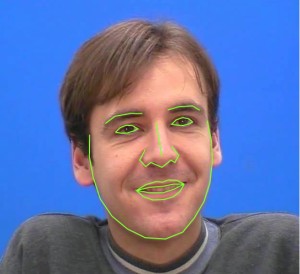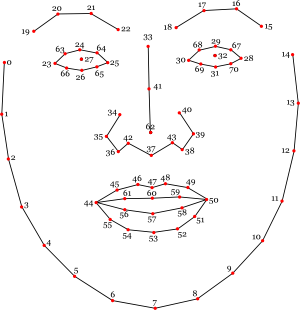https://github.com/auduno/clmtrackr
Javascript library for precise tracking of facial features via Constrained Local Models
https://github.com/auduno/clmtrackr
Last synced: about 1 month ago
JSON representation
Javascript library for precise tracking of facial features via Constrained Local Models
- Host: GitHub
- URL: https://github.com/auduno/clmtrackr
- Owner: auduno
- License: mit
- Created: 2012-08-18T12:24:43.000Z (over 12 years ago)
- Default Branch: dev
- Last Pushed: 2020-01-10T15:02:27.000Z (over 5 years ago)
- Last Synced: 2024-10-29T15:03:55.734Z (6 months ago)
- Language: JavaScript
- Homepage:
- Size: 57 MB
- Stars: 6,509
- Watchers: 314
- Forks: 1,159
- Open Issues: 63
-
Metadata Files:
- Readme: README.md
- License: LICENSE.txt
Awesome Lists containing this project
- starred-awesome - clmtrackr - Javascript library for precise tracking of facial features via Constrained Local Models (JavaScript)
README
clmtrackr
======
[](https://www.npmjs.com/package/clmtrackr)

**clmtrackr** is a javascript library for fitting facial models to faces in videos or images. It currently is an implementation of *constrained local models* fitted by *regularized landmark mean-shift*, as described in [Jason M. Saragih's paper](http://dl.acm.org/citation.cfm?id=1938021). **clmtrackr** tracks a face and outputs the coordinate positions of the face model as an array, following the numbering of the model below:
[](https://auduno.github.io/clmtrackr/examples/media/facemodel_numbering_new.png)
[Reference](http://auduno.github.io/clmtrackr/docs/reference.html) - [Overview](https://www.auduno.com/2014/01/05/fitting-faces/)
The library provides some generic face models that were trained on [the MUCT database](http://www.milbo.org/muct/) and some additional self-annotated images. Check out [clmtools](https://github.com/auduno/clmtools) for building your own models.
For tracking in video, it is recommended to use a browser with WebGL support, though the library should work on any modern browser.
For some more information about Constrained Local Models, take a look at Xiaoguang Yan's [excellent tutorial](https://sites.google.com/site/xgyanhome/home/projects/clm-implementation/ConstrainedLocalModel-tutorial%2Cv0.7.pdf?attredirects=0), which was of great help in implementing this library.
### Examples ###
* [Tracking in image](https://auduno.github.io/clmtrackr/examples/clm_image.html)
* [Tracking in video](https://auduno.github.io/clmtrackr/examples/clm_video.html)
* [Face substitution](https://auduno.github.io/clmtrackr/examples/facesubstitution.html)
* [Face masking](https://auduno.github.io/clmtrackr/examples/face_mask.html)
* [Realtime face deformation](https://auduno.github.io/clmtrackr/examples/facedeform.html)
* [Emotion detection](https://auduno.github.io/clmtrackr/examples/clm_emotiondetection.html)
* [Caricature](https://auduno.github.io/clmtrackr/examples/caricature.html)
### Usage ###
Download the minified library [clmtrackr.js](https://github.com/auduno/clmtrackr/raw/dev/build/clmtrackr.js), and include it in your webpage.
```html
/* clmtrackr libraries */
```
The following code initiates the clmtrackr with the default model (see the [reference](http://auduno.github.io/clmtrackr/docs/reference.html) for some alternative models), and starts the tracker running on a video element.
```html
var videoInput = document.getElementById('inputVideo');
var ctracker = new clm.tracker();
ctracker.init();
ctracker.start(videoInput);
```
You can now get the positions of the tracked facial features as an array via ```getCurrentPosition()```:
```html
function positionLoop() {
requestAnimationFrame(positionLoop);
var positions = ctracker.getCurrentPosition();
// positions = [[x_0, y_0], [x_1,y_1], ... ]
// do something with the positions ...
}
positionLoop();
```
You can also use the built in function ```draw()``` to draw the tracked facial model on a canvas :
```html
var canvasInput = document.getElementById('drawCanvas');
var cc = canvasInput.getContext('2d');
function drawLoop() {
requestAnimationFrame(drawLoop);
cc.clearRect(0, 0, canvasInput.width, canvasInput.height);
ctracker.draw(canvasInput);
}
drawLoop();
```
See the complete example [here](https://auduno.github.io/clmtrackr/examples/example.html).
### Development ###
First, install [node.js](http://nodejs.org/) with npm.
In the root directory of clmtrackr, run `npm install` then run `npm run build`. This will create `clmtrackr.js` and `clmtrackr.module.js` in `build` folder.
To test the examples locally, you need to run a local server. One easy way to do this is to install `http-server`, a small node.js utility: `npm install -g http-server`. Then run `http-server` in the root of clmtrackr and go to `https://localhost:8080/examples` in your browser.
### License ###
**clmtrackr** is distributed under the [MIT License](http://www.opensource.org/licenses/MIT)